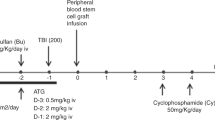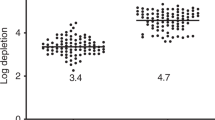Abstract
An advantage of CD34+ cell selection over antibody purging is that a component allograft is produced comprising a stem cell enriched and an unadsorbed fraction, the latter containing T cells which may be used for post-transplant immunotherapy. Initial reports with PBSC allografts suggested that T cell depletion (TCD) by CD34+ cell selection and post-graft cyclosporin A ± methotrexate was insufficient prophylaxis against acute GVHD. We compared sequential TCD (of a CD34+ cell-selected fraction) using a second (CD2) immunoaffinity step or Campath-1M monoclonal antibody and complement. Since a high stem cell ‘dose’ enhances engraftment across HLA barriers and improves overall post-transplant outcome, the recovery of CD34+ cells and progenitors were assessed. Sequential positive (CD34+) and negative (CD2+) immunoaffinity selection resulted in a 3.4 log depletion of T cells as compared to a 4.05 log depletion when CD34+ cell selection was followed by Campath-1M treatment. Recoveries of CD34+ cells, CFU-GM and BFU-E following double depletion using CD34+ cell selection plus CD2+ cell depletion were 28, 25 and 17% as compared to 20, 18 and 16% when CD34+ cells were treated with Campath-1M. The unadsorbed fraction contained 85% of the original T cells, from which donor leukocyte infusions in the range of 105 to 107 CD3+ cells per kg body weight of the recipient were harvested. Despite the advantages of component allografts, the loss of stem/progenitor cells may restrict sequential TCD steps unless single BM harvests are supplemented and/or replaced with mobilised PBSCs.
This is a preview of subscription content, access via your institution
Access options
Subscribe to this journal
Receive 12 print issues and online access
$259.00 per year
only $21.58 per issue
Buy this article
- Purchase on Springer Link
- Instant access to full article PDF
Prices may be subject to local taxes which are calculated during checkout
Similar content being viewed by others
Author information
Authors and Affiliations
Rights and permissions
About this article
Cite this article
Clarke, E., Potter, M., Hale, G. et al. Double T cell depletion of bone marrow using sequential positive and negative cell immunoaffinity or CD34+ cell selection followed by Campath-1M; effect on CD34+ cells and progenitor cell recoveries. Bone Marrow Transplant 22, 117–124 (1998). https://doi.org/10.1038/sj.bmt.1701296
Received:
Accepted:
Published:
Issue Date:
DOI: https://doi.org/10.1038/sj.bmt.1701296
Keywords
This article is cited by
-
Low-dose alemtuzumab (Campath®) in myeloablative allogeneic stem cell transplantation for CD52-positive malignancies: decreased incidence of acute graft-versus-host-disease with unique pharmacokinetics
Bone Marrow Transplantation (2004)
-
Oral busulfan pharmacokinetics and engraftment in children with Hurler syndrome and other inherited metabolic storage diseases undergoing hematopoietic cell transplantation
Bone Marrow Transplantation (2001)
-
Excessive T cell depletion of peripheral blood stem cells has an adverse effect upon outcome following allogeneic stem cell transplantation
Bone Marrow Transplantation (2001)
-
Allogeneic peripheral blood stem cell transplantation following CD34+ enrichment by density gradient separation
Bone Marrow Transplantation (2000)



